
by Sara E. Pratt Wednesday, June 15, 2016
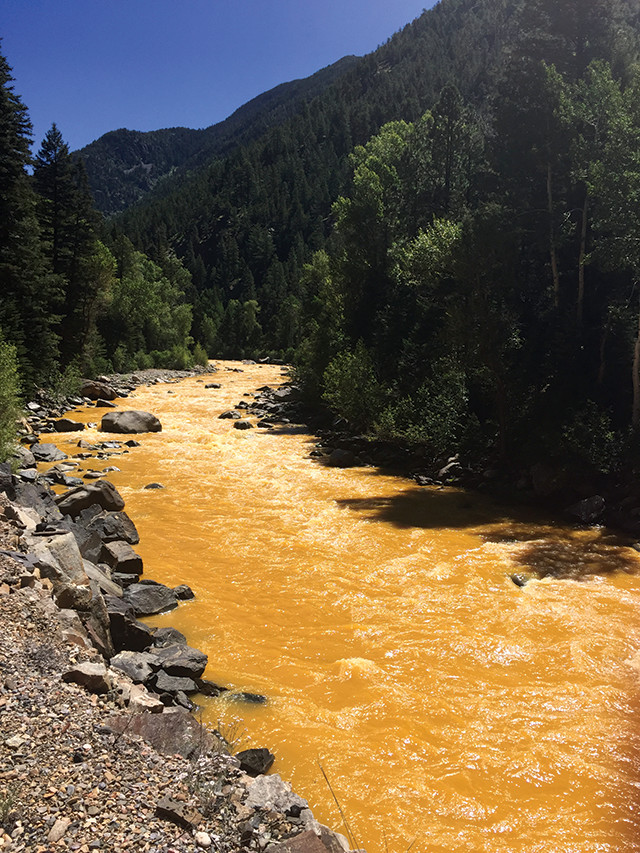
On Aug. 5, 2015, a 3-million-gallon spill of acid mine water from the Gold King Mine above Silverton, Colo., turned the Animas River orange. Credit: Riverhugger, CC BY-SA 4.0.
Not much happened around the Silverton Caldera in southwestern Colorado between 26 million years ago — when hydrothermal alteration of the caldera’s fractured granitic rocks left behind extensive veins of metal-rich ores — and 1871, when those deposits were discovered by prospectors. That’s when Silverton really started to boom. From 1871 to 1991 — when the Sunnyside Mine on the east side of Bonita Peak, the largest of dozens in the area, closed — an estimated $530 million worth of gold, silver, copper, lead and zinc were extracted from the Silverton Caldera. Most of the prospectors and mining companies that extracted that wealth are long gone, but a legacy of widespread environmental impacts remains.
Last summer, one of those impacts, a spill at the Gold King Mine — a late 19th-century gold mine above Silverton, Colo., that was abandoned in 1922 — made national news. On Aug. 5, 2015, contractors for the Environmental Protection Agency (EPA) investigating the ongoing acid mine drainage from the mine began excavating the earthen plug at the mine entrance. The plug sprang a leak, which rapidly became a blowout, and a bright orange plume of mine water gushed out of the tunnel and into Cement Creek and the Animas River.
The plume continued into New Mexico, where the Animas flows into the San Juan River before joining the Colorado River, which drains into Lake Powell. To compare pre- and post-spill water quality, scientists from EPA, the U.S. Geological Survey (USGS), the U.S. Bureau of Reclamation, and state environmental, public health and wildlife agencies from Arizona, Colorado, New Mexico and Utah sampled rivers, wells and irrigation canals before and after the plume passed to monitor levels of pollutants, including arsenic, cadmium, lead and mercury, among others.
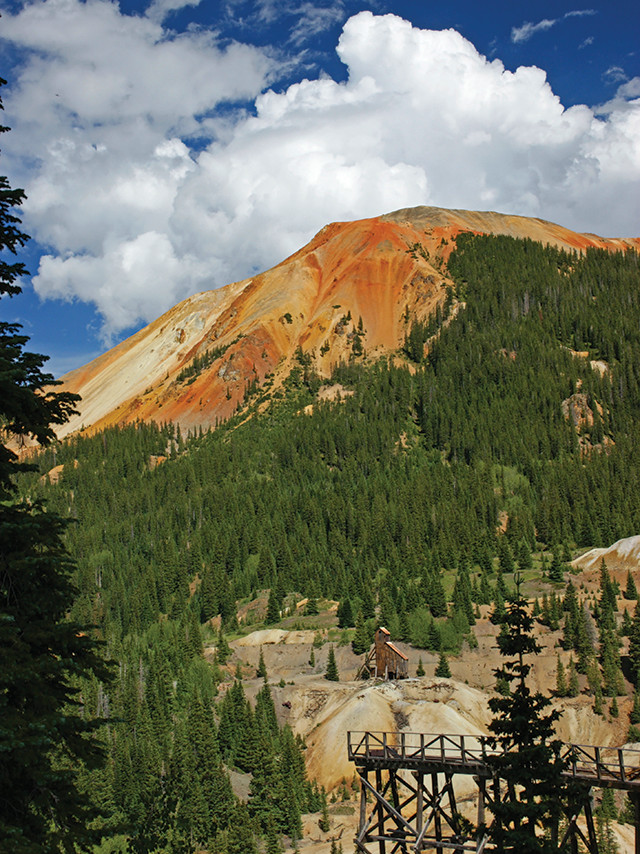
Hydrothermally altered bedrock in southwestern Colorado contains iron-sulfide minerals that can naturally produce acidic, heavy-metal discharges that impair water quality. Mining, which began in the late 1800s, exacerbates these reactions, producing acid mine drainage, which has plagued the region's waterways for more than a century. Credit: ©iStockphoto.com/Maxfocus.
A report published by the University of Arizona, which was updated in November 2015, summarized the findings. As alarming as the orange plume appeared, the water-quality data indicated that the pollution — which was continually diluted by river water as it moved downstream and as the metals precipitated or settled out of suspension — had almost entirely dissipated before it reached the Colorado River.
A map of the results of the water and sediment sampling published by the Arizona Geological Survey indicates that only a handful of samples, mostly in the upper reaches of the watershed in the early days of the spill, had pollutant levels that exceeded maximums established for drinking water standards. While the Animas and San Juan rivers remained closed to use for irrigation, drinking water and recreation for about 10 days, the impact to agriculture along the banks of the river was minimal although future crop yields could suffer from the shutdown of irrigation, according to the University of Arizona researchers, led by Karletta Chief, a hydrologist and tribal extension specialist in the Department of Soil, Water and Environmental Science.
The report also put the 3-million-gallon spill into perspective. Each year, Silverton mines collectively discharge more than 330 million gallons of acid mine drainage into the Animas River watershed — more than 100 times the volume of the Gold King spill. In other words, the Animas River is experiencing a Gold King-sized spill, albeit less concentrated, roughly every three days.
After more than a century of largely unmitigated mining in the West, Gold King is just the latest example of the slow-motion environmental problem that has been unfolding in hundreds of mines and along thousands of kilometers of waterways. The EPA’s involvement in this particular spill, however, is an unusual twist that has brought controversy and attention, but at least, researchers say, it is shining a light on the larger problem of abandoned mine lands and the complexities surrounding their regulation and remediation.
In recent decades, the movement to remediate abandoned mine lands has gained momentum, and geoscientists from many different fields, from environmental scientists and hydrologists to geologists and mining engineers, are bringing their expertise to bear in characterizing abandoned mine sites, monitoring their environmental impacts, and assessing and prioritizing them for reclamation. But regulatory, legislative and funding issues remain — and a looming geoscience workforce crisis may leave future cleanup projects in the lurch.
Today, the U.S. has an estimated 400,000 to 500,000 abandoned mine sites mostly concentrated in eastern coal mining regions, like Pennsylvania and West Virginia, and western hardrock and coal mining regions like Colorado and Wyoming.
“Abandoned mines” are those abandoned before 1977 by owners who pulled up stakes when the veins tapped out or market economics changed, making the mine no longer profitable to work. Prior to 1977, when the Surface Mining Control and Reclamation Act (SMCRA) established the national Abandoned Mine Land Reclamation Program, few regulations held former mine owners accountable for the environmental consequences of abandoning a mine. SMCRA assesses fees on active coal mining operations to pay for remediation of abandoned coal mine sites. There is, however, no similar program for hardrock abandoned mines.

Geologic map of the Silverton Caldera showing the Animas River, Cement Creek and Mineral Creek, which outline the ring-shaped caldera. Much of the mineralization occurs in radial and graben faults. Credit: USGS/Church, von Guerard and Finger, 2007 (modified from Casadevall and Ohmoto, 1977).
Abandoned mines can range from small prospect pits that merely pock the surface, to deep underground mines with kilometer upon kilometer of adits, shafts, drifts, stopes and tunnels. Such underground cavities often intersected the water table — the surface, or top, of water stored underground — requiring drainage tunnels or pumping during active mining. When mines were abandoned, however, the pumping often stopped, and drainage tunnels — which were graded to allow water, as well as loaded ore cars, to passively flow downslope — continued to drain.
Seeping groundwater can then pool in the mine and possibly escape into the surrounding environment, potentially leading to the most prominent and far-reaching of the many health, safety and environmental dangers posed by abandoned mines: the degradation of water resources by acid mine drainage.
Acid rock drainage can occur naturally, without mining, when rocks containing gold, silver, copper and other valuable metals — which also usually contain pyrite, an iron sulfide that, when exposed to air and water, creates sulfuric acid that further leaches metals from the rock — are exposed via weathering and erosion, fractures or exhumation. But mining accelerates and scales up this natural weathering, exposing vast amounts of fresh rock surfaces both inside and outside the mine to oxygen and water.
Until the 1930s, it was common practice to dump mine tailings directly into streams. When acid mine drainage flows into creeks or streams, it can impact reaches of a watershed far downstream, often leaving trails of iron-hydroxide deposits — “yellow boy” in mining terminology — that stain rocks and riverbanks red, yellow and orange. Today, tens of thousands of kilometers of U.S. rivers and streams are still affected by acid mine drainage.
In addition to water-quality impacts, other hazards that also require mitigation include spoils and tailings piles, open portals and shafts, underground fires, ground subsidence, explosive gases and rusting equipment, just to name a few.
In addition to Gold King, Colorado alone has more than 23,000 other abandoned mines posing varying degrees of threats. More than 6,000 have been remediated by the Colorado Division of Reclamation, Mining and Safety in cooperation with the Colorado Department of Public Health and Environment — but $66 million worth of unfunded projects remain listed on the national database of abandoned mine lands. Other states have similar backlogs.
In Pennsylvania, the state most impacted by acid mine drainage and with a long history of remediating it, abandoned mines discharge 300 million gallons of acid mine drainage per day, affecting more than 8,800 kilometers of streams, says Eric Cavazza, director of the state’s Bureau of Abandoned Mine Reclamation and past president of the National Association of Abandoned Mine Land Programs.
The problem may seem vast and intractable, but the science of acid mine drainage is well understood. And, over the last few decades, a well-stocked toolbox of mitigation techniques has been developed, including treating acid mine drainage waters with lime (calcium carbonate) to buffer the water’s pH to normal levels and channeling mine discharges through settling ponds to allow metals to precipitate.
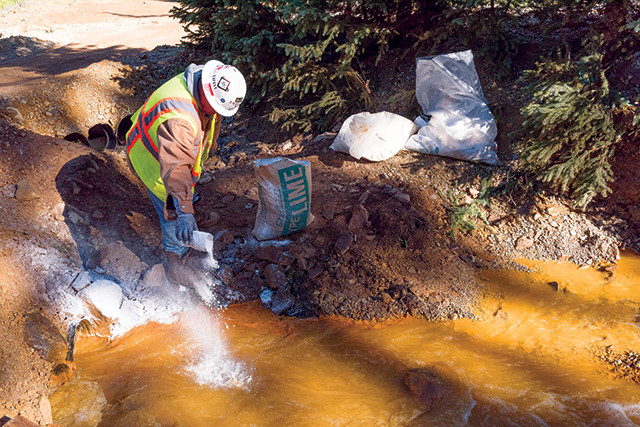
Acid mine drainage can be buffered with lime to raise the water's pH before it is discharged into waterways. Credit: EPA.
The bigger challenge is determining where and how to allocate limited resources, says Geoffrey Plumlee, a geochemist with USGS in Denver who testified before Congress in November 2015 on the role geoscientists can play in assessing and prioritizing remediation of abandoned mines.
In his testimony, Plumlee emphasized the importance of involving geoscience expertise at every stage: identifying and assessing sites, determining remediation options, and prioritizing projects based on the potential return. The task is figuring out which sites pose the greatest hazard and possess the greatest potential for improvement, he says.
Plumlee cites the example of Colorado’s Summitville Mine, a hardrock gold mine about 100 kilometers southeast of Silverton, where mining had occurred on and off since the late 1800s. In the 1980s, open-pit mining began using a new cyanide-leaching technique to dissolve gold from lower-grade ores. Almost from the beginning, heavy-metal discharges, pH levels lower than 3, and cyanide leakage plagued the operation.
In 1992, the mining company declared bankruptcy and was unable to meet its remediation responsibilities. In 1994, to prevent a major spill into the Alamosa River, the state of Colorado asked the EPA to designate it a Superfund site and take over cleanup, the cost of which has since exceeded $100 million.
The ore geology at Summitville — massive sulfide-rich volcanic deposits, with no underlying carbonates to help buffer and neutralize acidity — “was basically a geologic recipe for extreme acid rock drainage,” Plumlee says. Meanwhile, the ore geology at other mines can result in discharges near drinking-water quality. Although not all mine drainage is acidic, it can still carry substantial amounts of toxic elements.
“Not all mine drainage is created equal,” Plumlee says. “This is why understanding the geology of the deposits is so important to helping predict mine drainage chemistry.” That is just one way geoscientists can help prioritize different sites for cleanup. Another example of how geoscience may be brought to bear is the interdisciplinary “watershed approach,” exemplified in a 10-year pilot study of the effects of more than a century of historical mining in two watersheds: Boulder Creek in Montana and the Animas River in Colorado, which includes Gold King. In the comprehensive study, which ran from 1997 to 2007, researchers examined “the geology and geochemistry of rock and sediment, the hydrology and water chemistry of streams and groundwater, and the diversity and health of aquatic and terrestrial organisms” in each watershed.
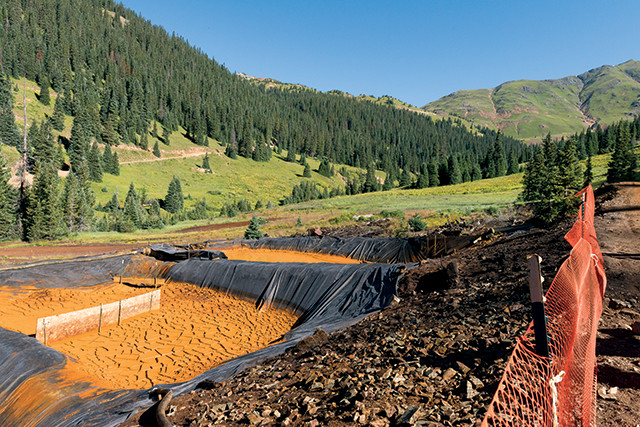
Diverting mine drainage into settling ponds allows iron oxides, heavy metals and other suspended particles to precipitate. Credit: EPA.
In the study, undertaken when the USGS implemented a new program in cooperation with federal land-management agencies called the Abandoned Mine Lands Initiative, researchers inventoried mine sites, analyzed an array of water, rock and mine waste samples, and characterized the geologic conditions controlling acidity and the release of toxic metals.
The results of the study, published in a 2007 report edited by USGS scientists Stanley E. Church, Paul von Guerard and Susan E. Finger, demonstrated the full potential of a comprehensive geotechnical assessment of watersheds impacted by mining, Plumlee says. Eight years later, that report became a vital resource for the teams investigating the Gold King Mine spill, helping to establish both pre-spill and pre-mining conditions.
Determining the natural conditions that existed in an environment prior to mining is important, Plumlee says, because it provides a baseline for the conditions that are technically feasible to achieve with remediation. This, in turn, can help planners set realistic goals for reclamation plans.
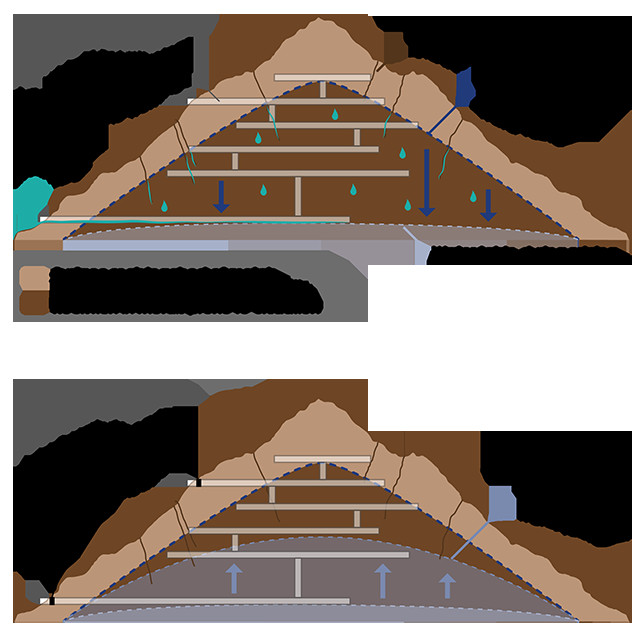
During mining (top), the water table is often lowered to access ore, exposing the rock to oxygen and creating acid mine drainage. Sealing off a mine can return the water table to pre-mining levels (bottom), creating anoxic conditions inside the mine and preventing further acidification. Credit: K. Cantner, AGI.
In establishing those conditions, it is important to remember that nature is not always pristine when left to its own devices. In Colorado, for example, the first European settlers gave streams names like Iron Creek, Alum Creek and Bitter Creek: names that alluded to natural acid rock drainage. In 1875, prior to intensive mining, the topographer of the Hayden Expedition noted the “iron-sulfate” waters of Cement Creek and Mineral Creek were not fit for drinking.
In 2011, the Colorado Geological Survey released a study identifying a number of streams whose headwaters, lying at elevations high above where mining impacts are felt, were acidic with high metals concentrations due to the hydrothermally altered metal-sulfide rocks in the surrounding geology. “Natural acid rock drainage has been active in Colorado for thousands, possibly millions of years,” the authors wrote.
In addition to understanding surface geology, knowing a site’s underground history is also crucial for remediation decision-making. Pairing historic documents with modern geoscientific technologies can help uncover that history.
If the Gold King spill did nothing else, it raised awareness that a better understanding of a mine’s underground structure and hydrologic conduits and connections, both man-made and natural, is needed to make effective remediation decisions.
Gold King was part of a complex of mines including the large Sunnyside Mine. During the decommissioning of the Sunnyside Mine in the 1990s, 12 bulkheads — bunker-like structures made of steel and concrete — were installed to seal off the mine. Like plugging a bathtub drain, the bulkheading prevented acid mine drainage from flowing out at the lowest levels of the mine. After bulkheading, the local water table rose 300 meters, flooding the mine.
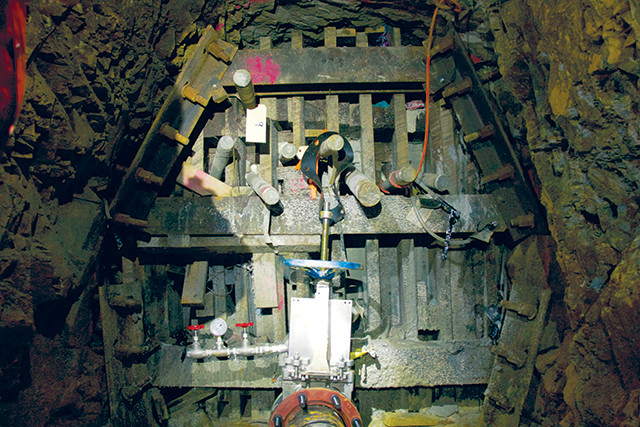
Bulkheads, like this one at the Red and Bonita Mine, help stop mine water discharges and allow engineers to monitor the mine pool. Credit: EPA.
Although it might seem like flooding a mine would exacerbate the aquatic chemical reactions that result in acid mine drainage, sometimes water is part of the solution.“The idea behind the bulkheads is to raise the groundwater table back to pre-mining levels and remove oxygen from the acid mine drainage equation,” says Kirstin Brown, a geologist with the Colorado Division of Reclamation, Mining and Safety.
Soon after Sunnyside was bulkheaded and the water table rose, however, acid mine drainage at nearby mines — including the Red and Bonita, Mogul, and Gold King, each of which had previously been dry or discharging minimally — began flowing again. The renewed flows of acid mine drainage into Upper Cement Creek and the Animas River were at first actively treated to raise the pH. However, in 2003 and 2004, treatment ceased when disputes among the mine companies over who was responsible for its cost led to litigation, and streamwater quality again declined.
In 2010, in an effort to better understand the flow of mine drainage into Upper Cement Creek, the Bureau of Land Management, the Animas River Stakeholders Group and the Colorado Department of Public Health and Environment contacted the Colorado Division of Reclamation, Mining and Safety about creating a three-dimensional model of how the mine workings might be intersecting the water table.
The task fell to Brown, who worked with the U.S. Office of Surface Mining Reclamation and Enforcement, to learn and use EarthVision software to create the model, which drew on data from historic mine maps, some of which the researchers had to track down and “dig out of people’s basements in Silverton,” she says.
After scanning and georeferencing the old maps, groundwater data was then overlaid on the workings. Researchers can’t see the groundwater surface underground, but they can see where it flows out on the surface. If a mine portal, spring or stream is flowing at the ground surface, it shows researchers a fixed point on the surface of the groundwater table. Researchers also can check groundwater head pressures on some bulkhead gauges to see the current pressure and depth of the water table.
The result was a model that can be manipulated in three dimensions that gives officials the ability to “better visualize and understand the groundwater in the mountain and to help communicate the problem [of acid mine drainage] to the public,” Brown says. The model could also “help make predictions for the best practices for remediation.”
Understanding the hydrology at work in a mine can also allow for the most potent remediation technique: controlling the water at its source to prevent contamination in the first place. Sealing off mine entries with bulkheads can help prevent water from entering mine workings, and the flow of water inside the mountain can be manipulated to direct acid water away from clean water sources, Brown says.
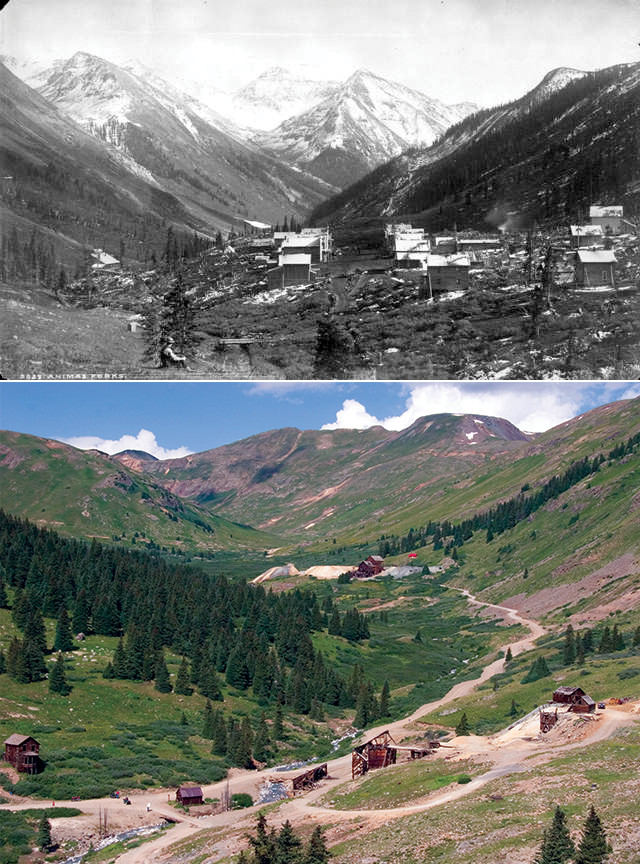
Top:The General Mining Act of 1872, established a century before the rise of environmental regulation, did not require remediation, leaving behind the remnants of many mines, and mining ghost towns, like Animas Forks, northeast of Silverton, Colo., shown here during mining in 1878. Credit: public domain. Bottom: Silverton, Colo., an abandoned mining town, shown in this 2006 photo. Credit: Kimon Berlin, CC BY-SA 2.0.
Remediation teams employ other tools and technologies to investigate what’s going on belowground. Salt and dye tracer solutions can be introduced into mine waters to follow the hydrological connections among the workings. Drilling boreholes to send cameras, sensors or other instruments down into a mine is another common technique, often used to check the pressure and depth of a mine pool prior to beginning work.
“We do a lot of mine pool evaluations and mine pool monitoring, which is what didn’t happen at Gold King that resulted in uncontrolled releases of mine water,” Cavazza says. “Before we open up an abandoned underground mine, we almost always drill and put in monitoring wells so we have a good understanding of exactly how large [the mine pool] is, what the volume is, and how to contain and control it if we decide to open it.”
Another way to figure out what’s going on is to go underground with an engineering team, says Brown, adding that this is only done after ground conditions have been assessed, stabilized and deemed safe. Once underground, teams can map faults and fractures, collect information about water quality and water sources underground, and assess how to control those sources, for example, by determining where to place bulkheads.
But, it turns out, it is getting harder and harder these days to find engineers trained to work in mines.
Since 1982, the number of accredited mining engineering schools has shrunk from 25 to 14 and for the last decade they have produced fewer than 200 graduates a year.
“Here in Pennsylvania, we have had a very difficult time recruiting new mining engineers to replace our mining engineers who are reaching retirement age,” Cavazza says. “There are fewer mining engineers being trained nationally, and there is probably going to be a continued need for them into the future.”
Last fall, in response to the Gold King spill, three bills were introduced in the U.S. House of Representatives Subcommittee on Energy and Mineral Resources chaired by Rep. Doug Lamborn (R-Colo.), who noted in his opening remarks the importance of having mining engineers on staff at agencies tasked with acid mine drainage cleanup.
“In the Committee’s investigation of the Gold King Mine spill, we discovered that, out of 15,326 employees, [the EPA] has no mining engineers and only 68 geologists, two of [whom] are assigned to [EPA] Region 8 where the spill occurred,” Lamborn said.
One bill, H.R. 3734, the Mining Schools Enhancement Act, would require the Office of Surface Mining Reclamation and Enforcement to direct 70 percent of its research funding to mining schools to help train the next generation of mining engineers.
In addition to mining engineers working on abandoned mine lands cleanup, it is “crucial to have economic and structural geologists who can help the mining engineers interpret and address the complexities of the geology, and hydrologists who can develop the detailed hydrologic models for groundwater flow,” Plumlee adds.
The other two bills introduced last fall, H.R. 3843 and H.R. 3844, propose to assess a maintenance fee on mineral claims for the next seven years, establish a federal “Good Samaritan” law, and establish a foundation that would oversee private gifts and bequests to fund abandoned mine lands remediation projects.
The bills are not the sweeping legislation that has been called for to replace the current law governing hardrock mining — the General Mining Act of 1872. Signed into law by Ulysses S. Grant to promote the settling of the West, it was enacted a century before the environmental movement took hold and made no provision for funding or regulation of remediation. “It’s never been updated, which is a very long time for an environmental law to be on the books,” Cavazza says. But, he says, “some people don’t want it updated.”
The most recent legislation proposing to update the 1872 mining act, H.R. 963, the Hardrock Mining Reform and Reclamation Act of 2015, was referred to subcommittee, where it remains. It would have, among other things, assessed reclamation fees to establish a fund for future cleanups and established a federal Good Samaritan law to waive some liability for private citizens, groups or companies who want to become involved in mine cleanup projects. Opponents contend that while domestic coal producers can pass the additional cost of reclamation fees onto consumers, U.S. mineral producers competing in a global market would suffer a competitive disadvantage if additional fees were imposed.
“There’s really never been the legislative will in Congress to enact a hardrock abandoned mine lands program,” Cavazza says.
Thus, hardrock abandoned mine lands are instead overseen by an alphabet soup of local, state and federal agencies, each with its own rules and guidelines. And funding to remediate a particular site may come from a hodge-podge of sources, including federal, state, and private partners who, in turn, get funding from a variety of sources, including SMCRA, Superfund, and the Clean Water Act Grant Program.
“Currently, no single source of funding, whether it be federal, state, tribal or private, is adequate on its own to address the magnitude of the problem that exists,” the Bureau of Land Management (BLM) and the U.S. Forest Service (USFS) reported in 2007. As of 2011, according to a General Accounting Office report, BLM, USFS, the Environmental Protection Agency and the U.S. Office of Surface Mining Reclamation and Enforcement had spent at least $2.6 billion to reclaim abandoned hardrock mines on federal, state, tribal and private lands.
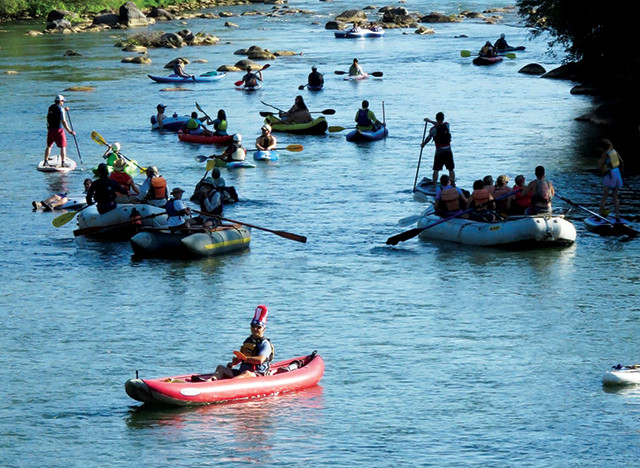
A wide range of private groups — from industry to wildlife conservation and recreational boaters and anglers — take an interest in mine remediation to clean up local waterways. Good Samaritan laws offer them protection from historic liability. Here, boaters celebrate the reopening of the Animas River for recreational use on Aug. 18, 2015. Credit: La Plata County Sheriff's Office.
Some of the private funding comes from corporations or groups — like Trout Unlimited, a nonprofit organization dedicated to conserving trout fisheries — that have a vested interest in cleaning up their local waterways. However, under certain laws anyone involved with mine cleanup in any way over the years can potentially be held responsible for environmental damage, even that which preceded their involvement with cleanup, and be liable for legal damages and cleanup costs.
Thus, Good Samaritan laws offer permits to waive or reduce the liability of private parties that want to participate in environmental cleanup projects. For example, if a group helped remediate a polluted stream that was previously unable to support aquatic life to the point that fish could survive in it, but not necessarily to the point that the water met the standards of the Clean Water Act, Good Samaritan laws might exempt the company from the more stringent requirement.
South Dakota and Pennsylvania are currently the only states with “Good Sam” laws. In Pennsylvania, Cavazza says, the 1999 law increased the number of private parties participating in acid mine drainage cleanup projects. But, he says, he suspects that many potential corporate partners are still dissuaded by legal teams who do not want to risk federal liability.
“I don’t know why you would want to discourage anybody from going in to try to clean something up that they had nothing to do with creating, that they are not in any way liable for, and for which they are providing their own resources,” says Cavazza, who last fall testified in his capacity as past president of the National Association of Abandoned Mine Land Programs (not in his role as a state official) to the benefits of Good Sam laws before the House subcommittee.
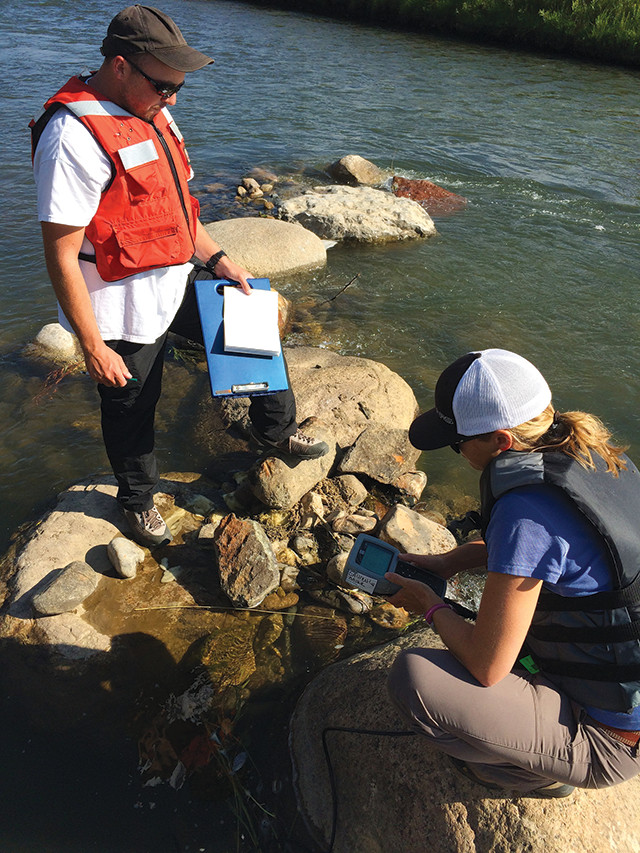
EPA workers monitor water quality in the Animas River in late August 2015. Both state and federal agencies plan to continue monitoring the water for long-term effects. Credit: EPA.
Whether the Gold King spill will provide the impetus to create a national program for hardrock abandoned mine lands remains to be seen. The case of Gold King is currently mired in litigation and hearings. At the site, the EPA has set up a temporary water treatment plant in the nearby ghost town of Gladstone to treat Gold King discharge before it reaches Cement Creek. Downstream, state and federal public health agencies and other researchers continue to monitor the Animas watershed, especially during spring runoff and high-water events that may mobilize sediments laden with heavy metals.
“Although there appear to be no short-term effects to health or the environment following the Gold King Mine spill,” the University of Arizona researchers wrote last November, “we will not understand the long-term impacts of this highly concentrated release of metals into our environment for quite some time.”
In April, in response to a request from Colorado Governor John Hickenlooper and towns, counties and tribes in the Animas and San Juan watersheds, the EPA proposed listing 48 historic mine sites in the Silverton Caldera as a Superfund site. Some residents of Silverton had long resisted the designation, despite the fact that it would bring additional federal resources for remediation, because it was thought that associating the town’s name with Superfund, often synonymous with hazardous waste, could threaten tourism. But after seeing the Animas run orange, many changed their minds.
If approved, the Superfund site will be called the Bonita Peak Mining District.
© 2008-2021. All rights reserved. Any copying, redistribution or retransmission of any of the contents of this service without the expressed written permission of the American Geosciences Institute is expressly prohibited. Click here for all copyright requests.